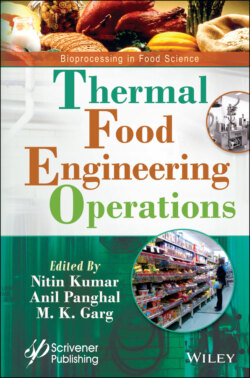Читать книгу Thermal Food Engineering Operations - NITIN KUMAR - Страница 37
2.2 Innovate Thermal Techniques for Food Reservation
ОглавлениеPasteurization and sterilization are the leading and finest processing techniques in the industrial sector. These techniques stop the rapid multiplication of spoilage and microbial organism present in the food and eliminate it by the application of heat in an acidic medium [11]. Temperature also plays a vital role in the thermal processing method. The higher the temperature of the food product while entering the process, the more speedily it helps in killing the microbes present in the food [12].
Though high-temperature traditional processing confirms the microbial safety of the food products by reducing it into 3 log cycle as per the 21 Code of Federal Regulation Part 114 [13], the limitations which arise during the application in terms of organoleptic and nutritional properties compels to limit the usage of these traditional techniques. These limitations also extend to non-uniform heating, degradation of the final quality of product, and low heat transfer. But currently, potential heating systems have come up as an alternative to replace the exciting conventional system, some of which are microwave heating, radiofrequency heating, ohmic heating, infrared heating, and instant control pressure drop technology (DIC) [14]. These alternative techniques of heat processing provide the advantages of volumetric and uniform heating while maintaining the quality of the final product and reducing the surplus treatment time by heating directly the food sample [15].
Few bacteria display an advanced heat resistance, subsequently being exposed to temperatures which only stress them [16, 17]. The growth medium of the organism, the growth temperature, and the phase of growth are significant issues concerning their aptitude to withstand heat. It is a very common phenomenon that the bacteria surviving different stress conditions have quite a high tolerance level to the different environmental situations and heat [18]. Inactivation does not mean that all the microbial cells are destroyed but it depends upon the number of cells present in the food sample. The maximum number of cells indicates the increased consumption of time for inactivation of the microorganisms in the food sample. The design of the thermal inactivation process for a given food depends on (i) the heat resistance of the most resistant microorganism (in the product); (ii) the food products dimensions; and (iii) thus the rate of heat penetration within the food matrix [19].
Therefore, this section brings, in particular, all the possible novel heat processing technologies for decontamination of spoilage and pathogenic microorganism present in the food. The table mentioned below provides a summary of the studies done on the microbial techniques and outcome which were achieved for the different food items and their change in properties after the treatment.
